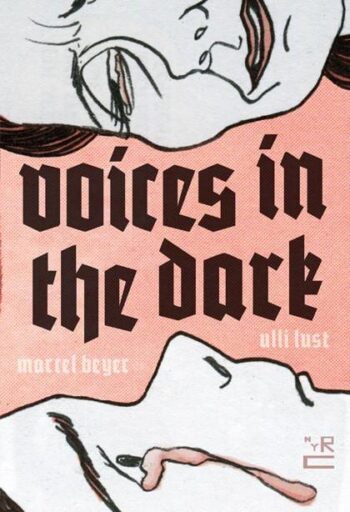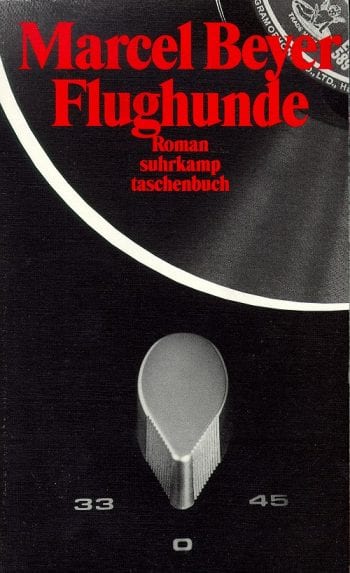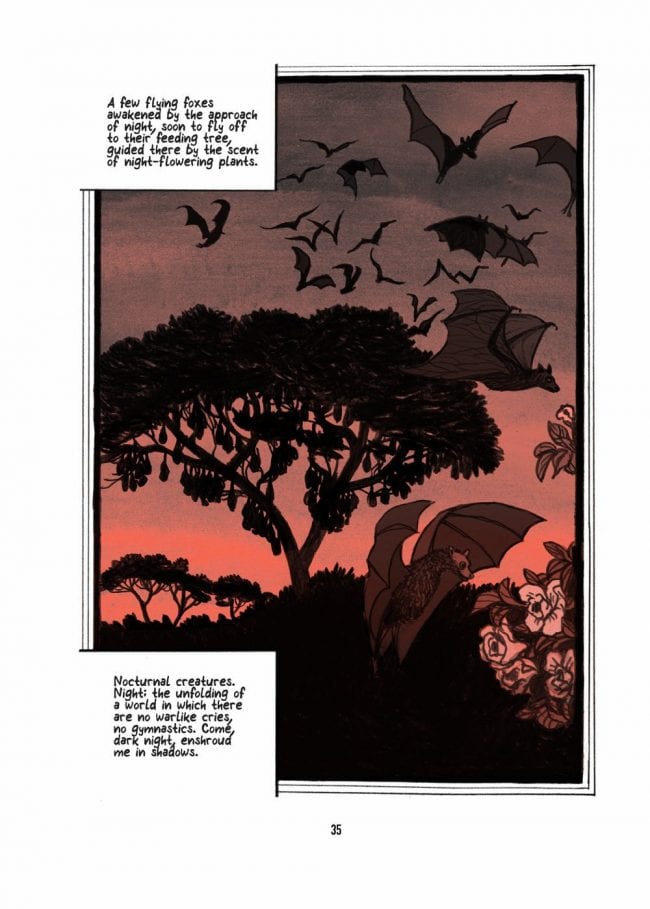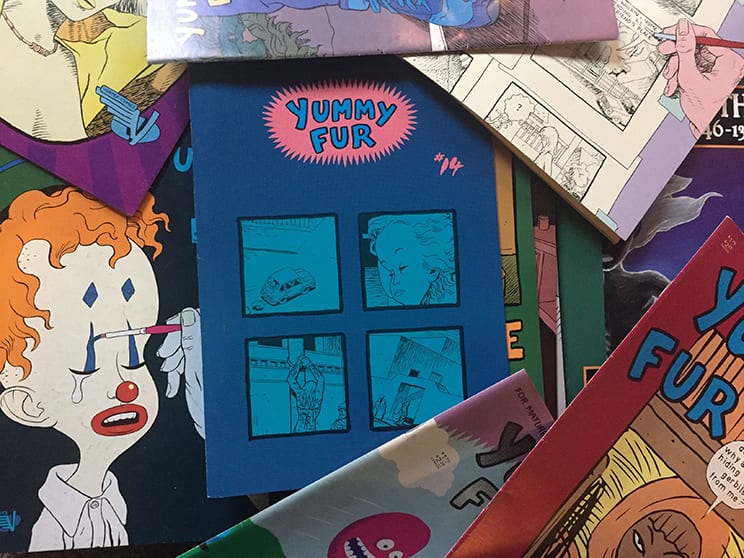In 2013 I had the pleasure of interviewing Ulli Lust on the train back to New York City after that year's Small Press Expo. She had just won the Ignatz Award for Best Graphic Novel for Today is the Last Day of the Rest of Your Life, and I had debuted my own first book at the show, The Love & Rockets Companion, so both us were exuberant as we settled in for the four-hour journey. The resulting interview was a spontaneous and candid conversation unlike any other I’ve ever conducted.
Now, almost exactly four years later, New York Review Comics has just published Voices in the Dark, Lust’s adaptation of Marcel Beyer’s prose novel, The Karnau Tapes. Although this English-language edition appears to be Lust’s follow-up to Today is the Last Day…, the book was actually published in France in 2013. Voices in the Dark is an historical fiction structured around parallel narratives, one focused on an obsessive sound technician who is slowly drawn into the Nazi movement, and the other a chronicle of wartime life from the perspective of the eldest daughter of the Reich Minister of Propaganda, Joseph Goebbels. It is, in every respect, an entirely different work than Today is the Last Day… and I was eager to learn what had inspired such a radical departure, and what the experience of adapting someone else’s work had been like. Though it would have been ideal if we could have recreated the circumstances of our first interview, Ulli lives in Berlin and teaches in Hannover so this one was conducted via email in October 2017.
Marc Sobel: What was it about Beyer’s novel that compelled you to devote three years of your life adapting it?
 Ulli Lust: I wanted to do an adaption of a novel and I gave myself two pragmatic requirements for choosing which one. First, the setting had to be located in a place I know (this eliminated about 70% of the novels). I had read a lot about Berlin history for another project (which resulted in my comics adaptation of children’s school essays from 1945). Second, I really wanted a strong female protagonist. Reading Marcel Beyer’s novel I felt his depiction of the girls, particularly Helga, was very accurate; it could have been like that. I was also inspired by the book’s intense, atmospheric scenario, which was very different from usual Third Reich narratives.
Ulli Lust: I wanted to do an adaption of a novel and I gave myself two pragmatic requirements for choosing which one. First, the setting had to be located in a place I know (this eliminated about 70% of the novels). I had read a lot about Berlin history for another project (which resulted in my comics adaptation of children’s school essays from 1945). Second, I really wanted a strong female protagonist. Reading Marcel Beyer’s novel I felt his depiction of the girls, particularly Helga, was very accurate; it could have been like that. I was also inspired by the book’s intense, atmospheric scenario, which was very different from usual Third Reich narratives.
I was also fascinated by how the war was described from the perspective of children. Helga Goebbels and her siblings perceived what they saw as normal and tried to deal with it accordingly. For example, the book shows a scene where they were playing but it devolved into an angry re-enactment of the cruel things they had observed. They had a very privileged life. They were in the eye of the hurricane yet they always thought they were safe, but you can’t dance with the devil and stay unharmed.
What was Beyer’s involvement in the adaptation? Did you collaborate with him?

You clearly did a lot of research for this book beyond just reading Beyer’s novel. Can you talk about that process and what some of your main sources were?
The research for a book is a phase I enjoy very much. In this case I visited several libraries. The internet provides a lot old images too but books are still better. For example, there’s a lot more information in books about old sound technology. The old technical devices looked much more interesting and were easier and more fun to draw than contemporary devices, which are mostly reduced to rectangular boxes. Imagine the exquisite form of an old gramophone with its big shell-shaped speaker compared to today’s iPod.
Of course I read a lot, too. Several people wrote memoirs about their experiences, like the nanny of the Goebbels children, the telephonist from Hitler’s bunker, one doctor who lived next to the bunker, and even Goebbels himself (that was hard to read; I only flipped through it).
I also visited the abandoned summerhouse of the Goebbels family outside Berlin. I had to walk there through the woods because I don’t have a car and there is no public transport. This family was sort of the glamour family of the Third Reich - a beautiful photogenic woman and six cute children, all named with the first letter H. The weekly news in the cinema (Wochenschau) often showed images of them playing in the garden, or celebrating this or that. The tragic photo, which Marcel Beyer describes in his novel, of a Russian soldier holding the body of the eldest daughter by the hair is quite brutal; I found that in an old English book in the library.
Other information about fashion, furniture, landscape, and all sorts of visual references are the fruits of my longstanding interest in history. I did a lot of this research for another abandoned project about Berlin history.
One of the main differences between this book and Today is the Last Day… is your use of color. Can you talk about your approach to color in this story?
A big reason why I liked The Karnau Tapes so much was its graceful language. The story didn't sound like a documentary, it felt more like a dark dream that slowly turns into a nightmare. Even the technician is so passionate about his field that his actions turn into something surreal. So the story needed a very distinct visual language and that's why I worked so intensively with the color.
I didn’t use a lot of color in my previous book. The punk story is also passionate, but somehow raw. Punk aesthetics are dirty, direct, and simple, so the focus was on black-and-white drawings. However, in the old children books I did (between ages 23 and 28), the coloring was a major aspect of the artwork. It was the only part of my drawings that I felt absolutely confident about. When I went to art school I made the decision to stick with black and white for a while because it forces a concentration on the form, but Voices in the Dark urgently needed the atmospheric float which color can provide so it was a perfect opportunity to revisit that old talent.
The color sets the tone and the temperature of the scene. Karnau is a melancholic character and a cool thinker who gets absorbed by the dark so blacks, blues, and yellows dominate. The children, by contrast, are very lively and cheerful in the first half of the book so warm red tones support those emotions. When their lives gets more oppressive, the colors lose their gloss. Unfortunately, the printing made everything a bit darker than I intended. The colors could have been brighter.
Old color photos from that period also helped a lot to find the right tones. You know, every period in time has its own colors. In fashion, for example, I was partly inspired by the palette of my grandmother.
What do you mean by that?
World War II was a big trauma for my grandparents. They were ordinary village people and the men were recruited while the women and children were left alone with the farm work. When we asked grandma to "tell us a story,” she would always talk about how horrible the war was and how hungry and frightened they were. She had been a young woman during the war, but over the years, like many old people, she didn’t change her clothing style much. She was also a very frugal woman, experience made her so, and she never threw anything out. She wore the same old clothes to work for years. The colors were bleached out but they hadn’t been very garish to begin with - brown, blue, olive green, and dirty pink (in German the color is called “alt-rosa”). I thought about her often while drawing the book.
Can you describe your approach to sounds in the book, particularly since they are such an integral part of the story?
First, even before the challenge of choosing a story came up, I had some very strange acoustic hallucinations in my inner ear. I heard women weeping, like weeping under the earth from the subsoil of the city. It was like I heard the mourning of the dead, people who had died in bombed houses, or the voices of women mourning over their dead families. I was not having any big troubles at the time; in fact my life was happy and fulfilled, so these sound-visions were irritating. After I had drawn the book, they were gone.
Comics to me are a musical medium. Drawings produce a visual tone (in Germany we call this Bildsprache, or “picture language"), the timing in the sequence of panels produces a rhythm, and staging the movement of the characters is like dance choreography (at least in my mind). In the book, Karnau is very sensitive and highly attentive to sounds. His ears are always wide open for all the incidental sounds in everyday life which normal people rarely even notice. This is one of the inspiring aspects of the book, it makes you more sensitive to the small sounds in the world.
In Germany we usually use English sound effects. There are very few generally understandable German sound words. For this story, I had to invent German sounding ones because English sounds would have been strange in the Nazi milieu. For example, in the bunker the sounds becomes a rhythmic constant din of machines, air conditioning, and warfare. These sounds build like the pressure in a steam engine, rising until it bursts.
What were the biggest challenges you encountered in adapting the text?
Some of the technical details were challenging. For example, in the novel
Karnau does battlefield recordings and listens to them secretly in his shelter in the army camp. If you think that through, it’s very difficult to implement. Karnau worked with the most advanced technology of his time, which were audio tape recordings. There were no wireless devices back then so I had to imagine Karnau running around on the battlefield with cable rolls, distributing microphones, with cables leading directly to his little shelter while nobody noticed it. I asked Marcel Beyer how he imagined this act. He just laughed and said he didn’t care for technical details because they were not important to the story. He said, you can get away with a lot simply by saying it. The readers just follow the assertion.
Karnau’s recordings of the children in the bunker was also a product of his imagination but in the book it is portrayed as actual fact so I had to try to figure out how this would have worked. Can you imagine secretly installing a big old audio tape recorder in a very small room filled with six bored children and they never notice it? I also have no idea how he could have managed to turn it on and off at night, but in the book he is able to do that and he secretly records the children’s last days.
Voices in the Dark is actually several years old but you also have a brand new graphic novel, Wie ich versuchte, ein guter Mensch zu sein (How I Tried To Be a Good Person), that was just released in Germany this year. What is that book about and will we see an English edition anytime soon?
In Today is the Last Day…, I told the story of a teenager who wanted to exit society. In the new book I am 23 to 28 and trying to find a place in the world as an artist and part-time mother, but mainly the story is about a long-term open relationship I had with two men, emphasizing the fact that all knew of one another. One was an older Austrian actor/musician, the other was a Nigerian mechanic of the same age. It worked out surprisingly well, that’s why I wanted to tell the story. Unfortunately, the events of the mad last few months have cast a shadow over the happy two years before. I have high hopes that there will be an English edition, but the book just came out one month ago in Germany so nothing is fixed yet. The reactions have been very enthusiastic so far, so hopefully the Americans will want to read it too.









